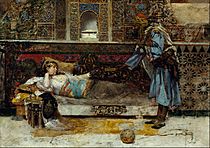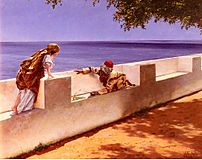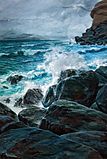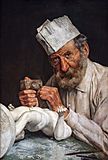Antonio Fabrés facts for kids
Quick facts for kids
Antoni Fabrés
|
|
|---|---|
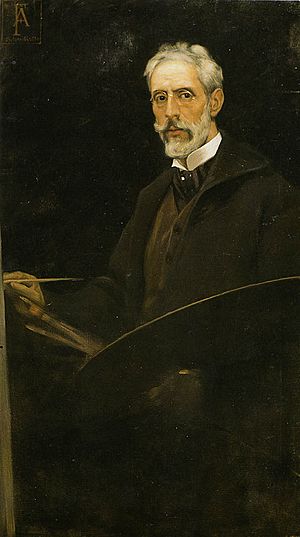
Self-portrait
|
|
| Born |
Antoni Maria Fabrés i Costa
1854 |
| Died | 1938 |
| Nationality | Spanish |
| Known for | Painting, sculpture |
Antoni Maria Fabrés i Costa (1854–1938) was a famous Spanish artist. He was known as both a sculptor and a painter. Antoni Fabrés lived during the late 1800s and early 1900s. He was from Catalonia, a region in Spain.
Contents
The Life of Antoni Fabrés
Antoni Fabrés was born in Barcelona, Spain, in 1854. He started studying art at a young age. When he was just 13, he began learning at the Escola de la Llotja. This was an art school in his hometown. His father was a draughtsman, someone who draws plans. His uncle was a silversmith, working with silver.
Early Career and Rome
At 21, Fabrés received a special grant. This allowed him to study art in Rome, Italy. He first created sculptures. But later in his career, he mostly focused on painting. He joined a group of artists with Marià Fortuny. They were known for their very realistic style. This style was called realism.
Their art became popular with wealthy people. These people liked paintings with exciting themes. They often wanted scenes from faraway lands or medieval times. Fabrés returned to Barcelona in 1886. Then, in 1894, he moved to Paris, France. His fame from Italy helped him open a large studio. Here, he created detailed paintings for rich clients.
Teaching in Mexico
In 1902, an art school in Mexico City called the Academia de San Carlos made a change. They wanted to teach modern art styles. These styles were popular in Europe at the time. Antoni Fabrés was asked to lead this important school. He took the place of Santiago Rebull.
Some of his students later became famous artists. They were part of what is called the Post-Revolutionary Movement in Mexican art. However, the teachers at the school found it hard to get used to Fabrés's unique style. They also struggled with his personality. In 1907, he returned to Rome. One of his last projects in Mexico was decorating a hall. This was in the mansion of Porfirio Díaz. He mainly used the Art Nouveau style for these decorations.
Later Life and Legacy
Fabrés was well-known in many places he visited. He was praised in Barcelona, London, Paris, Vienna, and Lyon. Near the end of his life, he faced a problem. In 1926, he gave many of his artworks to a museum. This was the Museu de Belles Arts de Barcelona. It is now called the Museu Nacional d'Art de Catalunya.
In return for his generous gift, Fabrés asked for a special hall. He wanted a hall in the museum named after him. However, the museum never built this hall. Fabrés protested several times, but the issue was never fixed. Antoni Fabrés died in Rome in 1938.
Selected Paintings
See also
 In Spanish: Antonio Fabrés para niños
In Spanish: Antonio Fabrés para niños


